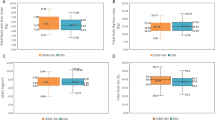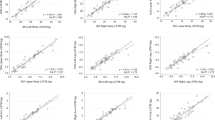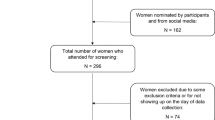Abstract
Background/objective:
Several articles have described body composition in anorexia nervosa, whereas little is known about this issue in underweight ballet dancers and constitutionally lean females. The main aim of this study was to assess whether phase angle (a bioimpedance variable related to body cell mass) differs according to the type of underweight in female adolescents and young women.
Subjects/methods:
Skinfold thicknesses and bioimpedance analysis (whole body and limbs) were evaluated in three groups of underweight patients (30 patients with anorexia nervosa, 10 constitutionally lean individuals and 15 classical dancers) and 30 normal weight controls.
Results:
There were no differences between the three groups of underweight patients with respect to anthropometric and bioelectrical impedance analysis (BIA) variables with the exception of phase angle. The latter was significantly higher in dancers, lower in anorectic patients and not different in constitutionally lean patients, as compared with controls.
Conclusions:
Phase angle (assessed by single-frequency BIA) appears to discriminate between different forms of underweight, being an effective marker of qualitative changes in body composition.
This is a preview of subscription content, access via your institution
Access options
Subscribe to this journal
Receive 12 print issues and online access
$259.00 per year
only $21.58 per issue
Buy this article
- Purchase on Springer Link
- Instant access to full article PDF
Prices may be subject to local taxes which are calculated during checkout
Similar content being viewed by others
References
Barbosa-Silva MCG, Barros AJD (2005). Bioelectrical impedance analysis in clinical practice: a new perspective on its use beyond body composition equations. Curr Opin Clin Nutr Metab Care 8, 311–317.
Bellizzi V, Scalfi L, Terracciano V, De Nicola L, Minutolo R, Marra M et al. (2006). Early changes in bioelectrical estimates of body composition in chronic kidney disease. J Am Soc Nephrol 17, 1481–1487.
Bossu C, Galusca B, Normand S, Germani N, Collet P, Frere D et al. (2007). Energy expenditure adjusted for body composition differentiates constitutional thinness from both normal subjects and anorexia nervosa. Am J Physiol Endocrinol Metab 292, E132–E137.
Durnin JV, Womersley J (1974). Body fat assessed from total body density and its estimation from skinfold thickness: measurements on 481 men and women aged from 16 to 72 y. Br J Nutr 131, 1833–1838.
Buchholz AC, Bartok C, Schoeller DA (2004). The validity of bioelecrical impedance model in clinical populations. Nutr Clin Pract 19, 433–446.
Eliakim A, Ish Shalom S, Gladi A, Falk B, Costantini N (2000). Assessment of body composition in ballet dancers: correlation among anthropometric measurements, bio-electrical analysis, and dual-energy X-ray absorptiometry. Int J Sports Med 21, 598–601.
Germani N, Galusca B, Le Roux CW, Bossu C, Ghatei MA, Lang F (2007). Constitutional thinness and lean anorexia nervosa display opposite concentrations of peptide YY, glucagon-like peptide 1, ghrelin. Am J Clin Nutr 85, 967–971.
Marra M, De Filippo E, Signorini A, Silvestri E, Pasanisi F, Contaldo F et al. (2005). Phase angle is a predictor of basal metabolic rate in female patients with anorexia nervosa. Physiol Meas 26, S145–S152.
Matthews BL, Bennell KL, McKay A, Khan KM, Baxter-Jones ADG, Mirwald RL et al. (2006). Dancing for bone health: a 3-year longitudinal study of bone mineral accrual across puberty in female non-elite dancers and controls. Osteoporos Int 17, 1043–1054.
Scalfi L, Marra M, De Filippo E, Caso G, Pasanisi F, Contaldo F (2001). The prediction of basal metabolic rate in female patients with anorexia nervosa. Int J Obes Relat Metab Disord 25, 359–364.
Scalfi L, Polito A, Bianchi L, Marra M, Caldara A, Nicolai E et al. (2002). Body composition changes in patients with anorexia nervosa after complete weight recovery. Eur J Clin Nutr 56, 15–20.
Stewart SP, Bramley PN, Heighton R, Green JH, Horsman A, Losowsky MS et al. (1993). Estimation of body composition from bioelectrical impedance of body segments: comparison with dual-energy X-ray absorptiometry. Br J Nutr 69, 645–655.
Yannakoulia M, Keramopoulos A, Tsakalakos N, Matalas AL (2000). Body composition in dancers: the bioelectrical impedance method. Med Sci Sports Exerc 32, 228–234.
Young N, Formica C, Szmukler G, Seeman E (1994). Bone density at weight-bearing and nonweight-bearing sites in ballet dancers: the effects of exercise, hypogonadism, and body weight. J Clin Endocrinol Metab 78, 449–454.
Author information
Authors and Affiliations
Corresponding author
Rights and permissions
About this article
Cite this article
Marra, M., Caldara, A., Montagnese, C. et al. Bioelectrical impedance phase angle in constitutionally lean females, ballet dancers and patients with anorexia nervosa. Eur J Clin Nutr 63, 905–908 (2009). https://doi.org/10.1038/ejcn.2008.54
Received:
Revised:
Accepted:
Published:
Issue Date:
DOI: https://doi.org/10.1038/ejcn.2008.54
Keywords
This article is cited by
-
Challenges of considering both extremities of the weight status spectrum to better understand obesity: insights from the NUTRILEAN project in constitutionally thin individuals
International Journal of Obesity (2023)
-
Body composition and energy expenditure in anorexia nervosa: preliminary data of outpatients with recovering and active disease
Journal of Eating Disorders (2022)
-
Phase angle obtained via bioelectrical impedance analysis and objectively measured physical activity or exercise habits
Scientific Reports (2022)
-
Underweight but not underfat: is fat-free mass a key factor in constitutionally thin women?
European Journal of Clinical Nutrition (2021)
-
Nutritional indicators and metabolic alterations in outpatients with anorexia nervosa: a retrospective study
Eating and Weight Disorders - Studies on Anorexia, Bulimia and Obesity (2021)



